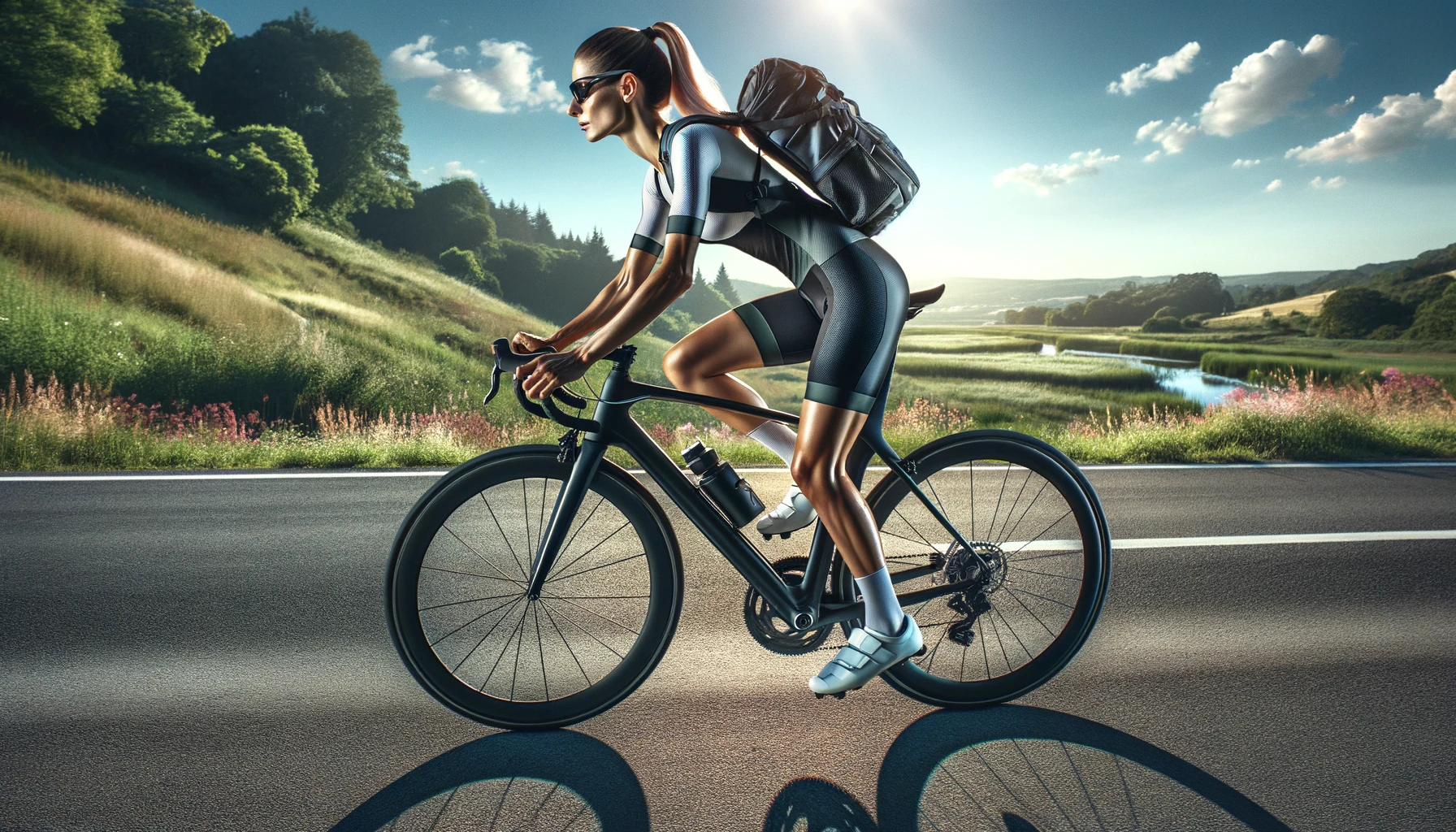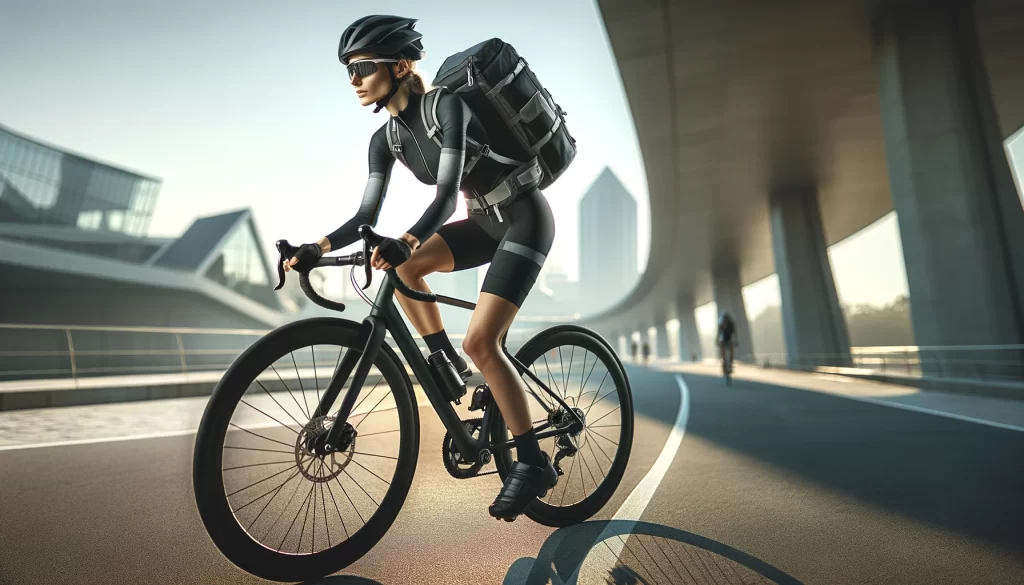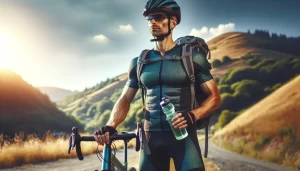Cycling bags and backpacks are more than just accessories; they are essential tools that enhance the practicality and enjoyment of every ride. Whether you’re commuting to work, embarking on a long-distance adventure, or simply running errands around town, the right cycling bag can make all the difference.
By providing secure storage for your belongings and improving overall bike handling, these bags are crucial for both novice and experienced cyclists alike. Choosing the perfect cycling bag involves balancing functionality with style and comfort.
As you delve into this article, you’ll discover the various types of bags available—from panniers and saddlebags to messenger bags and backpacks—each designed to meet specific needs and cycling environments. Keep reading to learn how to select the best bag for your riding style and the essential features that can elevate your cycling experience to new heights.

Image Source: Image Generated With DALL-E on ChatGPT
Types of Bags and Backpacks for Cycling
Cycling bags and backpacks are designed to enhance comfort and convenience for cyclists. These range from small saddle bags, which attach under the bike seat and are ideal for essential tools and spare tubes, to larger panniers that mount on the bike’s rear rack, suitable for commuting and grocery shopping.
For those needing to carry more, cycling backpacks and messenger bags are popular choices, offering stability and ergonomic benefits. Hydration packs are also essential for long-distance rides, providing easy access to water without needing to reach for a water bottle.
Steps to Choose the Right Cycling Bag or Backpack:
- Determine Your Needs: Assess the primary use, whether it’s for daily commuting, long tours, or casual rides.
- Consider Capacity: Choose a size that fits your typical load without being overly bulky.
- Check Compatibility: Ensure the bag fits securely with your bike model and doesn’t interfere with your riding.
- Prioritize Comfort: Look for features like adjustable straps and breathable materials, especially if choosing a backpack.
- Opt for Durability: Select materials that withstand weather conditions and daily wear and tear.
Comparative of Materials: Which to Choose?
When selecting materials for items like outdoor gear, clothing, or furniture, one must consider factors such as durability, comfort, and environmental impact. Common materials include natural fibers like cotton and wool, which are breathable and soft but may not be the most durable.
Synthetics like polyester and nylon offer excellent durability and moisture-wicking properties, making them ideal for outdoor apparel and equipment. Leather and metal are prized for their longevity and aesthetic appeal but can be heavy and less sustainable. Each material has its specific advantages and applications, depending on the intended use.
Tips for Choosing the Right Material:
- Identify the Use Case: Determine what the primary use of the material will be and the required properties.
- Consider the Environment: Think about the typical weather conditions and the environmental impact of the material.
- Balance Comfort and Durability: Often, more durable materials are less comfortable, so find a good balance.
- Assess the Care Requirements: Some materials may require special care or frequent maintenance.
- Research Sustainability Options: Explore eco-friendly materials that offer lower environmental impacts.
Road vs. Mountain Biking Bags and Backpacks
When choosing between bags and backpacks for road cycling versus mountain biking, the main considerations are based on the distinct demands of each type of riding. Road cycling bags are typically lightweight and aerodynamic to not impede speed and efficiency, often featuring frame or seat bags.
Mountain biking bags, on the other hand, need to be robust and capable of handling rough terrain. They often come in the form of hydration packs with space for tools and protective gear, and handlebar bags that offer easy access without affecting bike control.
Steps to Choose Between Road and Mountain Biking Bags:
- Assess the Terrain: Consider the type of surfaces you’ll be riding on and choose a bag designed for that environment.
- Prioritize Stability: For mountain biking, ensure the bag maintains stability and doesn’t shift during rides.
- Focus on Accessibility: Road bikers should look for bags that allow easy access to contents while riding.
- Check for Weather Resistance: Mountain biking bags should be waterproof or water-resistant.
- Evaluate the Mounting System: Ensure the bag can be securely attached to your specific bike model.
Essential Accessories for Cycling Bags and Backpacks
Cycling bags and backpacks can be enhanced with a variety of accessories to improve functionality and safety on the road or trail. Essential accessories include waterproof covers to protect your belongings from rain and mud, and internal organizers to keep tools, spare parts, and personal items neatly arranged.
Reflective strips or LED lights can be attached for increased visibility during night rides. For hydration packs, cleaning kits are vital for maintaining hygiene and functionality. Lastly, lockable zippers provide added security against theft when your bike is out of sight.
Tips for Selecting Accessories for Cycling Bags:
- Choose Based on Need: Identify which accessories will provide the most benefit based on your typical rides.
- Opt for High Visibility Options: Safety should be a priority, so consider accessories that enhance your visibility to others.
- Consider Modular Accessories: Look for modular options that can be added or removed as needed.
- Ensure Compatibility: Make sure the accessories fit well with your existing bags and don’t hinder your ability to ride.
- Invest in Quality: Durable accessories can withstand the elements and frequent use, offering better long-term value.
Safety: Bags and Backpacks with Signaling and Reflective Features
Cycling safety is significantly enhanced by the use of bags and backpacks equipped with signaling and reflective features. These specialized accessories are designed to increase the visibility of cyclists, particularly under low-light conditions or during night riding.
Reflective materials work by reflecting light back to its source, such as car headlights, making the cyclist more visible to drivers. Additionally, some modern cycling bags come with built-in LED lights or electronic signaling systems, which can indicate turns or stops via remote controls, further aiding in communication with other road users.
The integration of these features into cycling bags not only boosts safety but also adds to the convenience. For instance, the use of LED lights that can be easily controlled without removing the hands from the handlebars is a significant advancement. These lights often have various settings, such as steady light, blinking, or responsive modes that change with the cyclist’s behavior, like braking.
Reflective elements are typically incorporated in a manner that maximizes visibility from all angles, ensuring that whether a vehicle approaches from the side, back, or front, the cyclist’s presence is unmistakable. This proactive approach to cycling safety is essential for reducing the risk of accidents and enhancing peace of mind for both cyclists and their loved ones.

Image Source: Image Generated With DALL-E on ChatGPT
Tips for Packing and Weight Distribution in Cycling Bags
Proper packing and weight distribution in cycling bags can make a substantial difference in both comfort and bike handling. Ideally, weight should be distributed evenly to avoid any imbalance that could affect the cyclist’s control and stability.
For road cyclists, who often prioritize speed and efficiency, it’s essential to pack heavier items in the lower part of the bag or pannier to keep the bike’s center of gravity low and maintain ease of handling. In contrast, mountain bikers need to consider not only the weight but also how the load shifts during dynamic riding situations such as when jumping or navigating uneven terrain.
To optimize packing, start by categorizing items based on weight and frequency of use. Heavier items should be placed at the bottom of the bag, closer to the center of the bike, while lighter, frequently used items should be accessible from the top or side pockets. If using panniers, it’s crucial to ensure that the weight is evenly split between both sides of the bike to prevent pulling to one side.
Moreover, all cyclists should regularly reassess their pack to remove unnecessary items that might add excess weight. Strategic packing not only improves handling but also reduces physical strain, particularly on long rides, ensuring that cyclists can enjoy their journey with greater comfort and less fatigue.
Common Questions About Cycling Bags and Backpacks
1. What type of cycling bag is best for commuting?
For commuting, many cyclists prefer panniers, which are mounted on the sides of the bike. They can carry larger items and distribute the weight evenly, making them ideal for transporting work essentials or groceries.
2. Are cycling backpacks safe and comfortable for long rides?
Cycling backpacks are designed with ergonomics in mind, often featuring padded straps and breathable back panels to ensure comfort over long distances. However, for very long rides, panniers might be preferable to reduce back strain.
3. How important are waterproof features in cycling bags?
Waterproof features are crucial for all-weather cyclists. They protect your gear from rain and road spray. Look for bags with waterproof fabrics and sealed seams.
4. Can a regular backpack be used for cycling?
While any backpack can be used, those specifically designed for cycling offer advantages like stability in motion, reflective elements for safety, and an aerodynamic shape to reduce wind resistance.
5. How do I attach panniers to my bike?
Panniers require a bike rack, which is mounted over the rear wheel or on the front fork. The pannier then hooks onto the rack, usually with a simple, secure locking system.
Cycling bags and backpacks are integral to the cycling experience, catering to the needs of different cyclists, whether commuting, touring, or mountain biking. The right choice depends heavily on the type of cycling you do, the length of your ride, and what you need to carry.
It’s important to consider factors like capacity, weight distribution, comfort, and weather resistance when choosing the appropriate bag. Over time, as you use different types of bags, you’ll better understand which features matter most for your cycling habits and preferences.
Choosing the right bag can greatly enhance your cycling experience by making it easier to carry essentials, maintain your bike’s balance, and keep your belongings safe and dry. Whether you’re a daily commuter or an occasional adventurer, there’s a cycling bag out there that’s perfectly suited to your riding style and the demands of your route.
As cycling continues to grow in popularity, the innovation in cycling bags and accessories is likely to expand, offering even more options for efficient and comfortable travel.
Did you like the article? Be sure to check out more content like this in the Equipment And Accessories category, or see more related content below.






